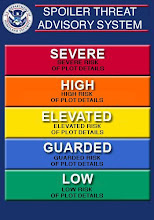 I saw an afternoon matinee of Where The Wild Things Are with two good friends in a theater full of families. Being a devout student of the Pixar school of filmmaking, this was certainly not the first time I found myself among the oldest non-parents in a movie theater audience. In fact, the same two friends went with me earlier this year for an afternoon matinee of the most recent Pixar release, Up.
I saw an afternoon matinee of Where The Wild Things Are with two good friends in a theater full of families. Being a devout student of the Pixar school of filmmaking, this was certainly not the first time I found myself among the oldest non-parents in a movie theater audience. In fact, the same two friends went with me earlier this year for an afternoon matinee of the most recent Pixar release, Up.There’s a comparison to be drawn between the two films. Up features a crotchety, elderly protagonist trying to reclaim the dreams of his youth by floating his house to South America with the aid of a couple thousand shiny balloons. The young protagonist in Wild Things, nine-year-old Max, spends the film dealing, directly and traumatically, with the pain of watching his youthful dreams die at his feet.
Allow me to be clear: based on Maurice Sendak’s controversial classic children’s book, Where The Wild Things Are isn’t necessarily a children’s movie. The film goes to great lengths to (successfully) capture the world (both real and imagined) through the perspective of a nine-year-old, but I suppose only those nine-year-olds as precocious (and sensitive and intelligent) as Max are going to interact with the film in the way intended. (I heard one child after the film proudly proclaim to his mother that he had stayed awake the entire time.) If you’re the lucky parent of a very smart and thoughtful kid, be prepared to answer a lot of questions about divorce.

I overheard somebody in a bar saying that Where the Wild Things Are is a movie that’s been marketed not to children or adults, but to hipsters. This fascinates me. The movie does come with an inarguable hipster cache: a song score by Karen O of the Yeah Yeah Yeahs, a writing credit for Dave Eggers, Charlie Kaufman-collaborator Spike Jonze at the helm. The first trailer for the film was cut to an Arcade Fire song.
I’m sure plenty of my bespectacled, Chuck Taylor’d brethren will be drawn to the film, and I daresay even those heavily guarded behind shields of irony, skepticism and apathy will find themselves socked in the jaw and the gut.
Wild Things is a difficult, intelligent masterpiece, full of raw emotions yet devoid of explanations and answers. The story, such as it is, centers around Max, that hyperactive and hypersensitive nine-year-old boy with a penchant for fort building and a serious destructive streak. His older sister ignores him (she’s got teenaged friends to concern herself with) and his loving mother (Catherine Keener) gives him the attention she can, but she has to juggle her son with her job and new boyfriend. Max is lonely, misunderstood and angry. Following a domestic dispute that climaxes with a nasty moment of violence, he runs out of the house, away down the street, across an ocean and into a forest to the the land of the Wild Things.
These giant beasts - actors in costume with computer-aided expressions – make Max their king almost immediately, and for one happy evening they destroy trees and pile on top of each other like a true, united family might. But inevitabely, fights break out and feelings are hurt; wounds are received (both physical and emotional) and Max is forced to confront the fact that his new kingdom, meant to be a refuge from his unhappiness at home, is no closer to perfect than anything else in his life and he certainly, absolutely, finally, is not in control.
What separates Where The Wild Things Are from the Pixar oeuvre (with the possible exception – as always – of the endlessly dark and thorny Wall-E) is hopelessness. Up, said one of my friends, “blows its emotional load ten minutes in”. It’s true to a certain extent: that film’s prologue is marked by despair and tragedy, and the body of the film covers the old fogey’s crusade for redemption and reconciliation. He finds himself in the company of a fatherless child, taking the place of the son he never had.
There are no surrogate fathers in Wild Things, and after the film’s own tragic prologue, our hero spends the film inside his head trying desperately to imagine one. Two of the beasts, Carol and KW, vie for Max’s affection and an pre-existing rift between them only grows wider and deeper. Voiced by James Gandolfini and Lauren Ambrose, respectively (finally getting some good work, those two, years after their tenures at HBO ended), the animals are manifestations of Max’s desires and failures, and the wild herd his family falling apart. Where the Pixar arc tends to follow a triumph over adversity, Jonze and Eggers bring Max down, down and down.
What we have here is devastating and bleak, and every note rings true. This is art that reminds me how blessed I am for having had a comparatively normal and happy childhood, and if the red faces of my two movie-going companions - both hard-nosed hipsters and children of divorce – were any indication, it ought to provide some camaraderie and comfort to those of us who weren’t so lucky.
This review appeared in a slightly different form in The Montague Reporter. Support your print media while you still can!




